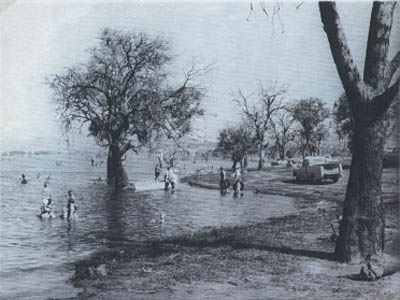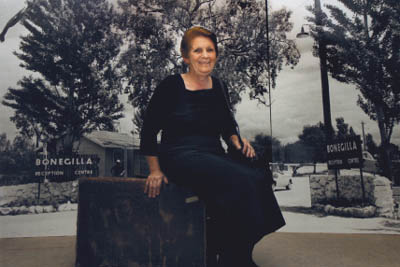Significance
Katina Vasililou poses before an exhibition photograph of the entry to the Reception Centre on a visit to mark the 55th anniversary of the first Greek arrivals, Peter Merkesteyn, Border Mail 10 March 2008.
Memories of the physical setting of the Bonegilla Reception Centre have endured: the heat, the cold, the sun, the flies, the space, the sense of isolation and bareness; Lake Hume, twisted grey gum trees, long walks to Albury, magpies carolling and crows cawing. Those who arrived as children now smile indulgently at the recall of sunburn and fears of swooping magpies, nasty spiders, possums, bull ants and snakes before they grew accustomed to the Australian sun and wildlife. They remember the perils of deep-pit latrines. For many of the young Bonegilla was a holiday camp.I was a Bonegillian before I understood I was Australian Wanda Skowrowska, father Poland, mother Latvia 1951.
The Block 19 remnant of the Bonegilla Reception Centre, the collection and the oral and written records associated with the Centre are of National Significance. They demonstrate and illuminate a defining change in immigration, for the post-war shift from prioritising Anglo immigration sources transformed political and social expectations of the cultural diversity of Australia.
About 24 of what were once 834 huts in the Centre as a whole remain. The barracks buildings and their layout demonstrate the basic conditions typical of migrant reception places. Block 19 retains a strong sense of what the migrant experience would have been like.

Picnic at Lake Hume, Laszlo Makay, Albury LibraryMuseum.
The National Archives of Australia holds official administrative records and migrant personal cards. The Bonegilla Collection at Albury LibraryMuseum is the principal holding of written and photographic evidence with memorabilia that underpins the collective memory of former residents. It provides first-hand observations that enliven understandings of arrival and settlement experiences.Together, the immigration records held at the National Archives of Australia, the Block 19 site, and the Bonegilla Collection form a triptych that yields insights into post-war migrant and refugee experiences from differing angles.
The site and the Collection attract many pilgrims, especially former residents and their descendants. For them, it seems that Bonegilla was more than a temporary staging camp. It was their Australian landing place, their first home. It was a threshold through which they passed to a new life in a new country. Many feel a special attachment to the place. This special attachment is acknowledged in the advice of the ABC's Standing Committee on Spoken English. It says that '/bohn-GIL-uh/ is the pronunciation for Bonegilla, the town and Army base, but when referring to the migrant hostel, the name should be pronounced [bon-uh-GIL-uh] because thatís how the migrants pronounced the name'.
For the public generally the construction of an Army camp of 1940 and its subsequent conversion into a migrant Centre in 1947 indicate attempts to cope with national vulnerability during and after the Second World War. It is a place to ask not only what newcomers made of Australia, but also what did Australia, in providing this facility, make of them. It prompts thinking about how Australia took in and still takes in strangers.
Bruce Pennay, 31 March 2008



